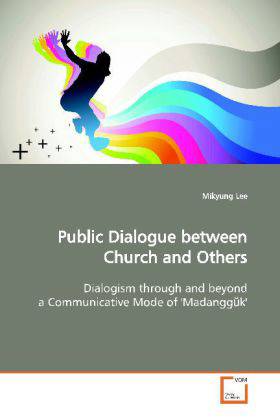
- Afhalen na 1 uur in een winkel met voorraad
- Gratis thuislevering in België vanaf € 30
- Ruim aanbod met 7 miljoen producten
- Afhalen na 1 uur in een winkel met voorraad
- Gratis thuislevering in België vanaf € 30
- Ruim aanbod met 7 miljoen producten
Zoeken
Public Dialogue Between Church and Others
Dialogism through and beyond a Communicative Mode of 'Madangg k'
Mikyung Lee
Paperback | Engels
€ 77,95
+ 155 punten
Omschrijving
The privatized and ghettoized church behind the wall is confronted by a dual crisis: an internal crisis of identity and an external crisis of relevance. Therefore, to shape a dialogical relationship through public dialogue is an essential task of the public church, the so-called "go-to-all" church. To execute "public dialogue" as the commission to the "go-to-all" this book concerns a Korean art- cultural pattern of public dialogue, particularly madanggŭk. Madanggŭk is a compound noun: madang (open place) + gŭk (theatre). It contains the three elements for public dialogue - place, a medium, and communicative principles for public dialogue. As an alternative with the purpose of overcoming "binary opposition" and shifting from monologism to "dialogism," this book suggests three alternative models of public dialogue: (1) Incarntional Public Dialogue, (2) Critical Public Dialogue, and (3) Festival Public Dialogue, Furthermore, in order to construct or transform into a "dialogical community," this study proposes "Six Stages of Dialogic Praxis" and "Four Procedures of Madang Public Dialogue."
Specificaties
Betrokkenen
- Auteur(s):
- Uitgeverij:
Inhoud
- Aantal bladzijden:
- 296
- Taal:
- Engels
Eigenschappen
- Productcode (EAN):
- 9783639112177
- Verschijningsdatum:
- 11/03/2009
- Uitvoering:
- Paperback
- Formaat:
- Trade paperback (VS)
- Afmetingen:
- 152 mm x 229 mm
- Gewicht:
- 435 g

Alleen bij Standaard Boekhandel
+ 155 punten op je klantenkaart van Standaard Boekhandel
Beoordelingen
We publiceren alleen reviews die voldoen aan de voorwaarden voor reviews. Bekijk onze voorwaarden voor reviews.











